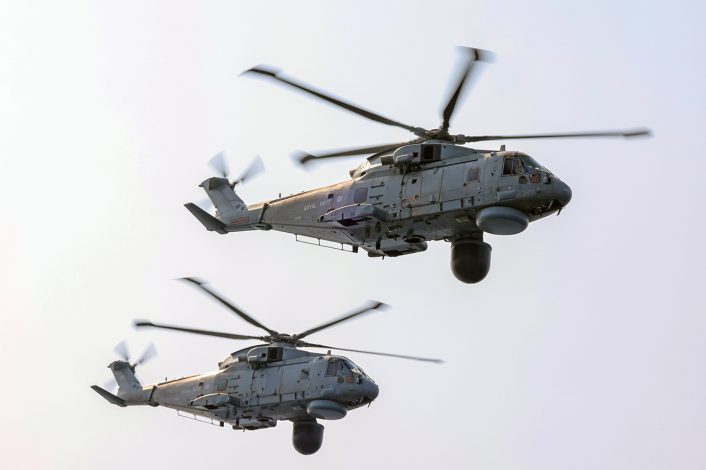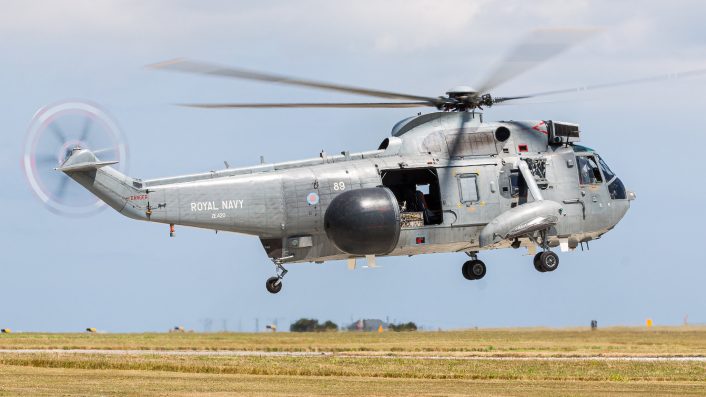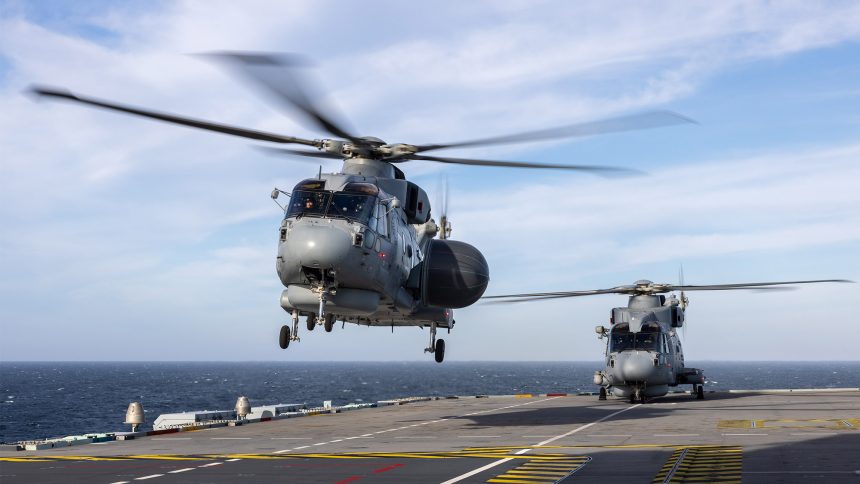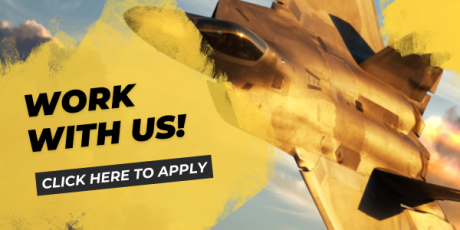The UK MoD issued a request for information for a new airborne surveillance system capable of operating from Queen Elizabeth class aircraft carriers.
With the Royal Navy’s present airborne early warning (AEW) platform, the Merlin Crowsnest, still due for withdrawal at the end of 2029, the UK Ministry of Defence (MoD) is seeking a solution that will allow the AEW role to be sustained. In the request for information (RFI) listing, the MoD’s objective is stated as to understand the capacity and capability of the industrial base to support this capability requirement.
The deadline for industry submissions is May 6, 2025, and the follow-on tender process is expected by Jan 1, 2026. The eventual contract is then expected to run for a five-year period from approximately Jan 1, 2027, to May 1, 2032.
Providing an AEW capability for the Queen Elizabeth class aircraft carriers and their carrier strike groups (CSG) has been a hotly debated topic ever since the carriers were first ordered. Without catapults and arresting wires, the Royal Navy carriers are unable to operate aircraft like the E-2D Hawkeye, which is flown from U.S. Navy and French Navy carriers.

Merlin Crowsnest had a protracted development process. Initial proposals in the early 2010s led to flight trials of two systems by 2014, with Thales’ proposal using a side-mounted radar in an inflatable radome, derived from those used on the Sea King ASaC7, selected the following year. The radar is mechanically scanned, and is an updated model of the Searchwater 2000 radar originally employed by the Nimrod MR2.
It wasn’t until 2021 that the first airframe entered service, just in time to deploy with the Carrier Strike Group 21 deployment. However, initial operating capability (IOC) was not declared until 2023, a full five years after the last Sea King ASaC7 was withdrawn.
Vigilance, the rival system offered by Lockheed Martin, would have seen the Merlin equipped with smaller, static pods mounted on both sides of the aircraft containing active electronically scanned array (AESA) radars. A version using arrays derived from the F-35 Lightning II’s AN/APG-81 was built alongside one using the Elta EL/M-2052.

Future AEW capabilities are widely expected to be provided by unmanned aircraft. New short take-off and landing (STOL) UAVs like the Gray Eagle STOL/Mojave from General Atomics could, to a degree, negate the disadvantage of not having catapults and arresting wires. While UAVs of this type are not much faster than helicopters, they can operate at much higher altitudes and extend the radar horizon of the task group significantly.
Advanced radar systems can be integrated onto these UAVs in pods, but weight limitations for STOL are a consideration that must be taken into account.
If funding would allow, the Royal Navy’s preferred option would seem to be the retrofitting of the carriers to accommodate electromagnetic catapults and arresting wires. This would not be a full conversion of the ships from STOVL to CATOBAR, but a hybrid option. Various proposals exist, ranging from short catapults for drone launches only, through to large systems suitable for manned fighter aircraft.
These would then allow larger unmanned platforms with greater payload capacity, potentially even jet-powered with increased speed and altitude performance.
The RN has ambitious plans for the QEC aircraft carriers and the Future Maritime Aviation Force (FMAF)https://t.co/CoHLjV4rXN pic.twitter.com/OllUggo3km
— Navy Lookout (@NavyLookout) June 3, 2023
An additional option, though perhaps further into the future, is the provision of AEW from platforms that are not organically generated by the carrier or task group. Systems like the Airbus Zephyr, which are sometimes referred to as pseudo-satellites, are electronically driven using solar cells for electricity generation. They can stay airborne for days, weeks, or even months, at a time, operating at altitudes in excess of 70,000 feet.
Currently, the major limitation of these designs is the payload capacity. Most of the airframe’s weight allowance is taken up by the large number of batteries required to sustain flight overnight, meaning the usable payload is only a few kilograms – nowhere near enough for an AEW radar system.
Reprieve for Crowsnest
Regardless of the option chosen, having the system procured, delivered, and declared operational by 2029 is an extremely ambitious target, and the natural fallback option is to extend the service life of Merlin Crowsnest to compensate.
On the face of it, this is a simple proposition, as the Merlin itself is currently expected to stay in Royal Navy service until 2040. However, the limited Merlin HM2 fleet is already stretched under the combined weight of its anti-submarine warfare, airborne early warning, and general maritime helicopter tasks.
A life extension will be required to keep the airframes not only up to date but generally airworthy, and as the helicopters rotate through this lengthy process the total fleet numbers will drop even further. One saving grace could be the introduction of the Leonardo Proteus rotary wing UAS (RWUAS), which is expected to begin flight trials this year. Proteus could not completely replace the Merlin, but it could provide the additional mass required to cover gaps in ASW provision.
rumours of T26-Merlin being sold as a package deal confirmed?
Naval News: What we’re seeing here is the configuration for the Royal Norwegian Navy, I see a Merlin helicopter with Norwegian crest on it …
1/2 https://t.co/8wpoZQxY8u pic.twitter.com/GaxiBFYJ1y
— David (@Davidfrigate) April 7, 2025
With current funding limitations, it is unlikely that any follow-on order for additional Merlins will arise, despite the prospect of new-build maritime variant Merlins being ordered by Norway alongside Type 26 frigates.
The Strategic Defence Review, reportedly due to be published imminently, is predicted to offer a scathing summary of the UK’s deteriorating defence capabilities. However, many commentators have warned against expecting any announcements of major capital expenditure in the review.









